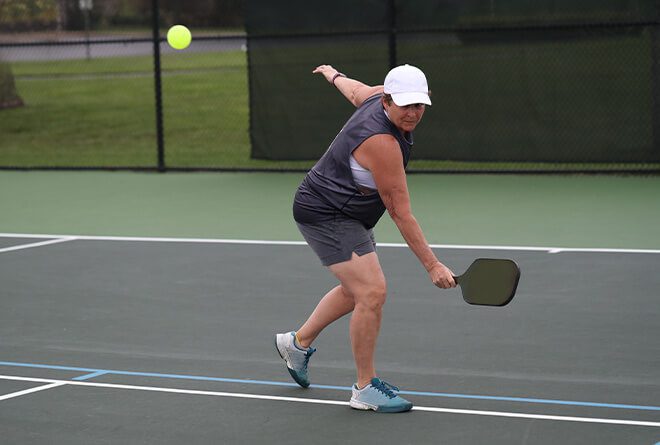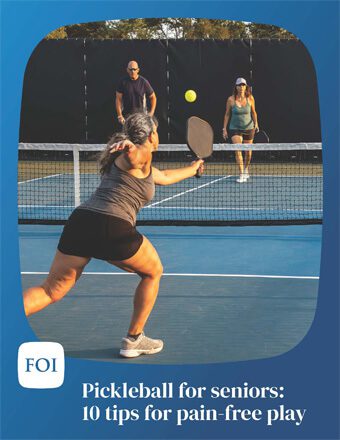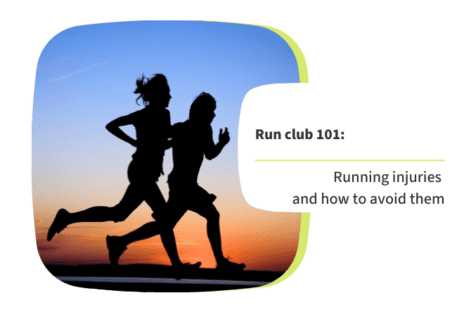6 signs you might have a pickleball knee injury

The beauty of pickleball is that nearly everyone can play it, even those who aren’t exceptionally coordinated. Because this hybrid game of tennis, ping pong and badminton is social and easy to learn, people are falling in love with the sport and playing for hours at a time. While that’s generally healthy, it can be a recipe for a pickleball knee injury if the player has poor technique or skips warm-up and stretching.
Pickleball is low-impact, but knee injuries are on the rise because players camp out in a crouch mid-court, twisting and lunging for balls. When someone goes from inactive to pickleball addict overnight, they might start noticing leg and knee pain from the amount of bending and pivoting with every point.
Read on to learn about common causes of pickleball knee issues, get tips for preventing pain and find out how to distinguish worrisome symptoms from harmless aches.
Pickleball knee injuries: 6 signs to watch out for
If your knees hurt from pickleball, it could be a sign of an injury or a chronic condition.
Be on the lookout for and pay special attention if you experience any of these six symptoms sometimes associated with pickleball knee injuries:
- Persistent pain, tenderness & swelling
- Reduced range of motion
- Instability & weakness
- Audible popping/crunching noises
- Stiffness
- Bruising
1. Persistent pain, tenderness & swelling
Continuous or recurring pain in the knee that doesn’t improve with rest could be a sign of injury, like a meniscal tear, or a condition, like osteoarthritis. Swelling around the knee might also indicate inflammation or fluid buildup in your knee joint. Conditions and injuries related to persistent pain, tenderness and swelling of the knee joint include:
- Meniscus tears: Damage to the cushion between the knee joint and femur bone
- MCL (medial collateral ligament) sprains: Injury on the inside of the knee where the shin and thigh bones connect
- Osteoarthritis: Erosion of the knee cartilage causing joints to ache and swell
2. Reduced range of motion
Difficulty bending or straightening the knee can signal joint issues or swelling. Conditions and injuries related to reduced range of motion in the knee joint include:
- Meniscus tears: Cause difficulty twisting the knee and moving side to side
- Rheumatoid arthritis: Inflammation and stiffness that inhibit range of motion
3. Instability & weakness
Feelings of the knee giving way or being unable to support weight during everyday activities or play. Conditions and injuries related to knee joint instability and weakness include:
- ACL (anterior cruciate ligament) tears: An injury in the center of the knee that reduces support when twisting or rotating, mostly felt at the front of the knee
- MCL (medial collateral ligament) sprains: Damage to the inside of the knee, causing pain and difficulty walking
- Patellar tendonitis: Injury to the tendon connecting the kneecap to the shinbone, causing the knee to buckle under weight
4. Audible popping/crunching noises
When moving your knee, hearing these sounds sometimes indicates that you might have knee cartilage damage. Conditions and injuries related to hearing popping /crunching noises include:
- Meniscus tears: Worn meniscus cartilage can rub together or against the joint
- Runner’s knee (patellofemoral pain syndrome): Noises sometimes indicate a misaligned kneecap
5. Stiffness
Having a stiff knee, especially first thing in the morning or after sitting for a long time, can be related to joint issues, such as:
- Osteoarthritis: The knee loses flexibility when cartilage in the knee joint disappears with age
- Gout: A buildup of uric acid can result in flare-ups of stiffness
6. Bruising
Visible bruising around the knee might indicate a painful, severe injury like a ligament tear or impact injury.
- Impact injuries: Blunt trauma to the knee from a collision or fall
- Ligament tears: An acute injury from jumping, twisting or falling
Consult an experienced sports medicine physician if symptoms related to pickleball knee pain become severe or don’t respond to home remedies like rest, ice, anti-inflammatories and bracing. This addictive racquet sport is safe to play as long as you realize the risks of wear and tear and remain diligent about preventing a pickleball knee injury.
Knee conditions & injuries from pickleball
Knee issues account for about 6 percent of pickleball injuries and can make it challenging to get around pain-free off the court, too, causing your health and happiness to suffer.
Symptoms could indicate a minor problem (that will respond to treatment at home) or a severe injury (that needs immediate medical attention).
Here are some things you can do to decrease the likelihood you’ll experience pain from a pickleball knee injury or condition:
- Maintain a healthy weight to reduce strain on the knees
- Warm up gradually on the court
- Stretch after playing
- Weight train to build up the muscles around your knee joint and strengthen your whole leg by doing side leg lifts
- Learn proper technique
- Improve core strength for stabilization and balance
- Stay balanced on both feet while playing and avoid risky jumps and lunges
Meniscus tears
A rip in the meniscus is one of the most common pickleball injuries. The meniscus is the protective padding in the knee joints that absorbs impact and allows the knee to move smoothly.
The sudden movements and direction changes in pickleball can cause a tear, which can worsen quickly if left untreated. Meniscus tears tend to occur from acute movements rather than gradual use. You may hear a “pop” and then experience immediate pain and swelling.
An untreated meniscus tear can lead to a more significant injury, immobility, surgery and arthritis.
MCL sprains
The MCL is a ligament that runs down the inside of your leg. It protects the knee in side-to-side movements.
The quick pivots and twists you make to react to the ball at close range put the MCL at risk for acute injury, like a sprain. You’ll feel immediate pain and later notice swelling if you sprain your MCL. A popping sound at the time of the injury could indicate a torn ligament, which is worse than a sprain.
MCL sprains are a type of MCL injury that should be treated immediately with the RICE method—rest, ice, compression and elevation. Reducing the swelling quickly will help the knee heal faster. See a doctor for a targeted treatment plan if the pain and swelling persist for a couple of days or you can’t put weight on the leg.
ACL tears
An ACL tear occurs in the ligament in the middle of the knee, toward the front. It’s typically caused by a sudden burst of movement or a bad landing after a jump. When muscles around the knee become brittle with age and inactivity, the ACL is more prone to injury.
A popping sound usually accompanies an ACL tear. It hurts significantly and swells rapidly, and you may feel like the knee is going to give way under the slightest amount of weight.
Apply ice, elevate the knee, and avoid walking on it if you suspect you have a pickleball ACL injury. See a doctor as soon as possible. A severely torn ACL might require surgery.
Patellar tendonitis
Patellar tendonitis refers to the inflammation of the kneecap tendon, also called “jumper’s knee. Pickleball’s foundational crouching stance and repetitive jumping put the knee tendon under constant strain.
Tendonitis sets in gradually from wear and tear. The pain and swelling worsen over time until moving around the court is difficult. Rest is the first line of defense against patellar tendonitis, plus ice and gentle stretches. When you resume play, warm up properly and consider wearing a knee brace for support.
See a doctor if the symptoms don’t respond to your rehabilitation efforts at home or you have difficulty walking.
FAQs about pickleball and knee pain
Prevent or treat a knee injury from pickleball by following this advice endorsed by the specialists at the Florida Orthopaedic Institute (FOI).
Can I play pickleball if I have “bad knees”?
Pickleball has many benefits for the mind and body. Arthritis or chronic soreness from a past injury doesn’t have to keep you out of the game. You just need to be diligent about prevention and taking care of your knees.
Maintain a regular stretching routine, do leg exercises to strengthen the knee area, wear a knee brace and warm up and recover with stretching every time you play. And take it easy—don’t overplay. Take extra precautions, and don’t play through soreness.
Is it safe for people with knee replacements to play pickleball?
Yes, most orthopedic surgeons sign off on playing pickleball once you have sufficiently recovered from knee replacement surgery and physical therapy.
Make sure your PT knows about your goal to play pickleball so you can incorporate targeted exercises into your regimen. The recovery period is typically three to six months. Follow the doctor’s instructions to prevent injury from jumping and twisting, build back up slowly and stick to doubles for a while.
Can you play pickleball with a torn meniscus?
Can you still win a game with a torn meniscus? Sure. Is it a good idea? No.
Playing on a torn meniscus risks making it worse. One wrong move and you could exacerbate the injury to the point of requiring minimally invasive outpatient surgery. Then you’re in for a long and somewhat painful recovery. Consult a physician for a treatment plan if you suspect you have a meniscal tear.
Does wearing a knee brace while playing pickleball help prevent injuries?
Yes, the right knee brace provides support and helps prevent pickleball knee pain from setting in.
Braces vary in levels of support, from suppression sleeves for mild cases of knee discomfort to form-fitting braces with advanced support features. Look for one that’s comfortable, adjustable and fits snugly without cutting into your leg.
Be proactive about pickleball knee pain
There’s no doubt pickleball is becoming more popular. The sport is fun and can help you maintain flexibility, strength and a healthy weight—especially if you combine regular play with a sensible diet.
That said, while all of the swinging involved in playing can take a toll on your shoulders at any age, pickleball for seniors involves a more significant risk since, with aging, your tendons aren’t as elastic as they once were, and this increases your chance of experiencing an overuse-related knee injury.
Get convenient, comprehensive knee care in Central Florida
Whether you have pickleball shoulder pain, a knee injury, or something else from playing this low-impact sport, we can help. The care team at Florida Orthopaedic Institute includes specialists in every aspect of orthopedics. If you’re having discomfort, let us create a customized treatment plan to help you—safely—get back into action and keep active.
Don’t wait to schedule an evaluation with a specialist at one of our many convenient locations in Central Florida. Call us or request an appointment today.
You might also like:
- Dr. Christopher Baker on Fox 13: Preventing Pickleball Injuries
- Patient Story: Surgery for ACL Injury
- Patient Story: Total Knee Replacement

Pickleball for seniors: 10 tips for pain-free play
About Florida Orthopaedic Institute
Founded in 1989, Florida Orthopaedic Institute is Florida’s largest physician-led orthopedic group. It provides expertise and treatment of orthopedic-related injuries and conditions, including adult reconstruction and arthritis, foot and ankle, general orthopedics, hand and wrist, orthopedic trauma, shoulder and elbow, spine, interventional pain management, sports medicine, podiatry, physical medicine and rehabilitation, chiropractic services, and physical and occupational therapy, among others. The organization treats patients throughout its surgery centers in North Tampa, South Tampa, and Citrus Park, at several orthopaedic Urgent Care centers and at office locations in Bloomingdale, Brandon, Citrus Park, Gainesville, Lakeland, Northdale, North Tampa, Ocala, Palm Harbor, Riverview, South Tampa, Sun City Center and Wesley Chapel.
October 31, 2024


